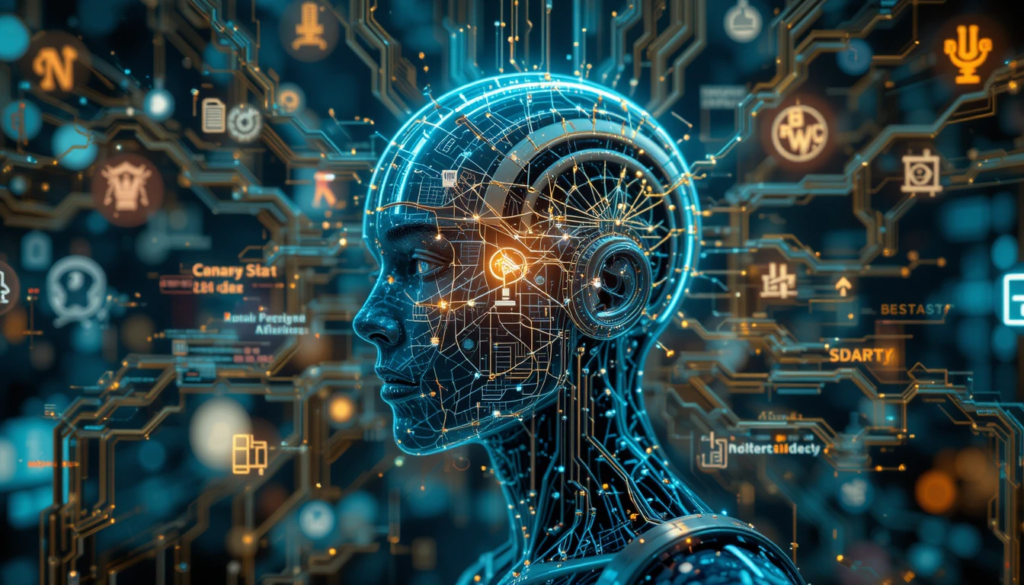Table of Contents
ToggleIntroduction
In the rapidly evolving digital landscape, cybersecurity has become more critical than ever. With the rise of sophisticated cyber threats, traditional security measures struggle to keep up. Enter Artificial Intelligence (AI) in Cybersecurity—a game-changer in the world of cybersecurity. AI enhances security frameworks, detects anomalies, and strengthens defense mechanisms against cyber threats. In this article, we’ll explore seven ways AI in cybersecurity is transforming protection and shaping a more secure digital future.

The Growing Cybersecurity Challenges
Cyber threats are evolving at an unprecedented pace. Hackers employ advanced techniques such as ransomware, phishing, malware, and AI-driven cyberattacks. As organizations rely more on digital systems, cybercriminals exploit vulnerabilities, leading to data breaches, financial losses, and reputational damage.
Common Cybersecurity Challenges:
Increasing Number of Cyber Threats – Cyberattacks are growing in frequency and complexity, making traditional security measures inadequate.
Human Error – Many security breaches result from human mistakes, such as weak passwords or falling for phishing scams.
Rapid Technological Advancements – The digital landscape changes constantly, making it difficult for security teams to stay ahead.
Shortage of Cybersecurity Experts – A lack of skilled professionals makes it harder to combat threats effectively.
7 Ways AI in Cybersecurity is Revolutionizing Protection
AI is transforming cybersecurity by providing automation, real-time threat detection, and predictive analytics to combat cyber threats proactively. Here’s how AI is making a difference:
1. AI-Powered Threat Detection and Prevention
AI can analyze vast amounts of data in real time to identify suspicious patterns that might indicate cyber threats. Machine learning (ML) algorithms help detect anomalies that traditional security systems might overlook.
Example: AI-powered systems like IBM Watson for Cyber Security and Darktrace continuously scan network activities to identify malicious behavior.
2. Automated Security Response
AI reduces response time by automating threat mitigation. When AI detects a threat, it can immediately trigger security protocols, such as isolating compromised systems or blocking malicious IP addresses.
Example: AI-driven Security Information and Event Management (SIEM) systems automatically detect and respond to cyber threats.
3. Advanced Phishing Detection
Phishing remains one of the most common cyber threats. AI can analyze email content, sender behavior, and communication patterns to identify phishing attempts more accurately than traditional filters.
Example: Google’s AI-powered spam filters prevent millions of phishing emails from reaching inboxes daily.
4. Behavioral Analysis and Anomaly Detection
AI continuously monitors user behavior to detect anomalies. If an employee logs in from an unusual location or accesses sensitive data unexpectedly, AI flags it as a potential security threat.
Example: Financial institutions use AI to detect fraudulent transactions by analyzing spending patterns.
5. AI in Malware Analysis
Traditional antivirus software relies on known virus signatures, making them ineffective against new malware strains. AI, however, detects malware based on behavioral analysis rather than relying on existing virus definitions.
Example: AI-powered antivirus programs like Cylance use ML to predict and block malware attacks.
6. Enhancing Identity and Access Management (IAM)
AI improves identity security by implementing biometric authentication, facial recognition, and adaptive authentication techniques to strengthen access control.
Example: AI-powered multi-factor authentication (MFA) systems analyze user behavior and grant access only if the patterns match usual activity.
7. Predictive Cybersecurity Using AI
AI doesn’t just detect attacks—it predicts them. By analyzing past incidents, AI can foresee potential threats and recommend proactive security measures.
Example: AI-driven cybersecurity solutions like Microsoft Defender predict and prevent potential cyberattacks.
The Benefits of AI in Cybersecurity
AI offers multiple advantages in strengthening cybersecurity, including:
Speed and Efficiency – AI can analyze and respond to threats much faster than human security teams.
Reduced False Positives – Traditional security systems often generate too many false alarms, making it harder for security professionals to focus on real threats. AI enhances accuracy by reducing false positives.
Cost Savings – AI automates security tasks, reducing the need for large security teams and minimizing financial losses from breaches.
Proactive Security – AI helps organizations anticipate and prevent attacks instead of merely reacting to them.
Challenges and Limitations of AI in Cybersecurity
While AI is revolutionizing cybersecurity, it is not without its challenges:
AI Itself Can Be Hacked – Cybercriminals can manipulate AI systems using adversarial attacks.
High Implementation Costs – AI-powered security solutions can be expensive to develop and maintain.
Need for Human Oversight – AI is not foolproof; human experts are still required to analyze complex cyber threats.
The Future of AI in Cybersecurity
The integration of AI into cybersecurity is only just beginning. Future advancements may include:
AI-Driven Autonomous Security Systems – Fully automated security systems capable of self-healing after an attack.
Quantum AI in Cybersecurity – Quantum computing could enhance AI’s ability to process vast security datasets faster.
Improved AI Explainability – AI models will become more transparent, helping security professionals understand their decision-making processes.
Conclusion
AI is playing a crucial role in transforming cybersecurity, helping organizations detect, prevent, and mitigate cyber threats with greater accuracy and speed. However, as AI continues to evolve, so do cybercriminal tactics. By combining AI with human expertise, organizations can build a robust and resilient cybersecurity framework for the future.
AI-driven cybersecurity is no longer an option—it’s a necessity. Businesses and individuals must embrace AI-powered security solutions to stay ahead of cybercriminals and safeguard digital assets in an increasingly connected world.